A total solar eclipse will occur at the Moon's descending node of orbit on Wednesday, March 30, 2033, with a magnitude of 1.0462. A solar eclipse occurs when the Moon passes between Earth and the Sun, thereby totally or partly obscuring the image of the Sun for a viewer on Earth. A total solar eclipse occurs when the Moon's apparent diameter is larger than the Sun's, blocking all direct sunlight, turning day into darkness. Totality occurs in a narrow path across Earth's surface, with the partial solar eclipse visible over a surrounding region thousands of kilometres wide.
Totality will be visible in Nome, Alaska, Utqiaġvik, Alaska and the Chukchi Peninsula in the mid-morning hours. This is the last of 55 umbral eclipses of Solar Saros 120. The first was in 1059. The total duration is 974 years.
Images
Details of totality in some places or cities
| Country or Territory | Place or City | Start
of |
Start of total eclipse (Local Time) |
End of total eclipse (Local Time) |
Duration of total eclipse |
End of partial eclipse (Local Time) |
Magnitude |
|---|---|---|---|---|---|---|---|
| Gambell, Alaska | 08:57:55 (sunrise) | 09:44:22 | 09:46:40 | 2 min 18s | 10:42:15 | 1,044 | |
| Nome, Alaska | 08:51:53 | 09:46:05 | 09:48:35 | 2 min 30s | 10:45:17 | 1,045 | |
| Anadyr, Chukotka Autonomous Okrug | 05:39:24 (sunrise) (March 31) | 06:47:12 (March 31) | 06:48:01 (March 31) | 50 s | 07:42:27 (March 31) | 1,043 | |
| Uelen, Chukotka Autonomous Okrug | 05:55:06 (March 31) | 06:48:57 (March 31) | 06:50:55 (March 31) | 1 min 58 s | 07:47:02 (March 31) | 1,045 | |
| Kotzebue, Alaska | 08:56:01 | 09:50:48 | 09:53:19 | 2 min 31s | 10:50:25 | 1,046 | |
| Utqiagvik, Alaska | 09:04:08 | 09:59:46 | 10:02:22 | 2 min 36s | 10:59:52 | 1,046 |
Related eclipses
Eclipses in 2033
- A total solar eclipse on March 30.
- A total lunar eclipse on April 14.
- A partial solar eclipse on September 23.
- A total lunar eclipse on October 8.
Metonic
- Preceded by: Solar eclipse of June 12, 2029
- Followed by: Solar eclipse of January 16, 2037
Tzolkinex
- Preceded by: Solar eclipse of February 17, 2026
- Followed by: Solar eclipse of May 11, 2040
Half-Saros
- Preceded by: Lunar eclipse of March 25, 2024
- Followed by: Lunar eclipse of April 5, 2042
Tritos
- Preceded by: Solar eclipse of April 30, 2022
- Followed by: Solar eclipse of February 28, 2044
Solar Saros 120
- Preceded by: Solar eclipse of March 20, 2015
- Followed by: Solar eclipse of April 11, 2051
Inex
- Preceded by: Solar eclipse of April 19, 2004
- Followed by: Solar eclipse of March 11, 2062
Triad
- Preceded by: Solar eclipse of May 30, 1946
- Followed by: Solar eclipse of January 30, 2120
Solar eclipses of 2033–2036
This eclipse is a member of a semester series. An eclipse in a semester series of solar eclipses repeats approximately every 177 days and 4 hours (a semester) at alternating nodes of the Moon's orbit.[1]
The partial solar eclipse on July 23, 2036 occurs in the next lunar year eclipse set.
| Solar eclipse series sets from 2033 to 2036 | ||||||
|---|---|---|---|---|---|---|
| Descending node | Ascending node | |||||
| Saros | Map | Gamma | Saros | Map | Gamma | |
| 120 | March 30, 2033 Total |
0.9778 | 125 | September 23, 2033 Partial |
−1.1583 | |
| 130 | March 20, 2034 Total |
0.2894 | 135 | September 12, 2034 Annular |
−0.3936 | |
| 140 | March 9, 2035 Annular |
−0.4368 | 145 | September 2, 2035 Total |
0.3727 | |
| 150 | February 27, 2036 Partial |
−1.1942 | 155 | August 21, 2036 Partial |
1.0825 | |
Saros 120
This eclipse is a part of Saros series 120, repeating every 18 years, 11 days, and containing 71 events. The series started with a partial solar eclipse on May 27, 933 AD. It contains annular eclipses from August 11, 1059 through April 26, 1492; hybrid eclipses from May 8, 1510 through June 8, 1564; and total eclipses from June 20, 1582 through March 30, 2033. The series ends at member 71 as a partial eclipse on July 7, 2195. Its eclipses are tabulated in three columns; every third eclipse in the same column is one exeligmos apart, so they all cast shadows over approximately the same parts of the Earth.
The longest duration of annularity was produced by member 11 at 6 minutes, 24 seconds on September 11, 1113, and the longest duration of totality was produced by member 60 at 2 minutes, 50 seconds on March 9, 1997. All eclipses in this series occur at the Moon’s descending node of orbit.[2]
| Series members 50–71 occur between 1801 and 2195: | ||
|---|---|---|
| 50 | 51 | 52 |
 November 19, 1816 |
 November 30, 1834 |
 December 11, 1852 |
| 53 | 54 | 55 |
 December 22, 1870 |
 January 1, 1889 |
 January 14, 1907 |
| 56 | 57 | 58 |
 January 24, 1925 |
 February 4, 1943 |
 February 15, 1961 |
| 59 | 60 | 61 |
 February 26, 1979 |
 March 9, 1997 |
 March 20, 2015 |
| 62 | 63 | 64 |
 March 30, 2033 |
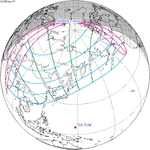 April 11, 2051 |
 April 21, 2069 |
| 65 | 66 | 67 |
 May 2, 2087 |
 May 14, 2105 |
 May 25, 2123 |
| 68 | 69 | 70 |
 June 4, 2141 |
 June 16, 2159 |
 June 26, 2177 |
| 71 | ||
 July 7, 2195 | ||
Metonic series
The metonic series repeats eclipses every 19 years (6939.69 days), lasting about 5 cycles. Eclipses occur in nearly the same calendar date. In addition, the octon subseries repeats 1/5 of that or every 3.8 years (1387.94 days). All eclipses in this table occur at the Moon's descending node.
| 22 eclipse events between June 12, 2029 and November 4, 2116 | ||||
|---|---|---|---|---|
| June 11–12 | March 30–31 | January 16 | November 4–5 | August 23–24 |
| 118 | 120 | 122 | 124 | 126 |
 June 12, 2029 |
 March 30, 2033 |
 January 16, 2037 |
 November 4, 2040 |
 August 23, 2044 |
| 128 | 130 | 132 | 134 | 136 |
 June 11, 2048 |
 March 30, 2052 |
 January 16, 2056 |
 November 5, 2059 |
 August 24, 2063 |
| 138 | 140 | 142 | 144 | 146 |
 June 11, 2067 |
 March 31, 2071 |
 January 16, 2075 |
 November 4, 2078 |
 August 24, 2082 |
| 148 | 150 | 152 | 154 | 156 |
 June 11, 2086 |
 March 31, 2090 |
 January 16, 2094 |
 November 4, 2097 |
 August 24, 2101 |
| 158 | 160 | 162 | 164 | |
 June 12, 2105 |
 November 4, 2116 | |||
Tritos series
This eclipse is a part of a tritos cycle, repeating at alternating nodes every 135 synodic months (≈ 3986.63 days, or 11 years minus 1 month). Their appearance and longitude are irregular due to a lack of synchronization with the anomalistic month (period of perigee), but groupings of 3 tritos cycles (≈ 33 years minus 3 months) come close (≈ 434.044 anomalistic months), so eclipses are similar in these groupings.
The partial solar eclipses on April 8, 1902 (part of Saros 108) and January 5, 1935 (part of Saros 111) are also a part of this series but are not included in the table below.
| Series members between 2000 and 2200 | ||||
|---|---|---|---|---|
 July 1, 2000 (Saros 117) |
 June 1, 2011 (Saros 118) |
 April 30, 2022 (Saros 119) |
 March 30, 2033 (Saros 120) |
 February 28, 2044 (Saros 121) |
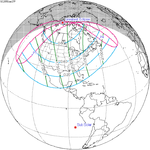 January 27, 2055 (Saros 122) |
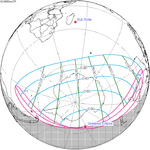 December 27, 2065 (Saros 123) |
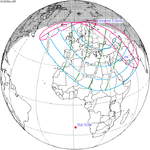 November 26, 2076 (Saros 124) |
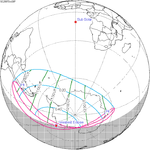 October 26, 2087 (Saros 125) |
 September 25, 2098 (Saros 126) |
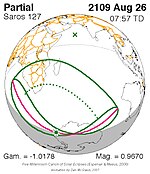 August 26, 2109 (Saros 127) |
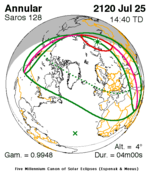 July 25, 2120 (Saros 128) |
 June 25, 2131 (Saros 129) |
 May 25, 2142 (Saros 130) |
 April 23, 2153 (Saros 131) |
 March 23, 2164 (Saros 132) |
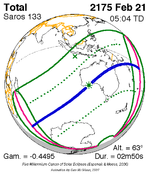 February 21, 2175 (Saros 133) |
 January 20, 2186 (Saros 134) |
 December 19, 2196 (Saros 135) | |
Inex series
This eclipse is a part of the long period inex cycle, repeating at alternating nodes, every 358 synodic months (≈ 10,571.95 days, or 29 years minus 20 days). Their appearance and longitude are irregular due to a lack of synchronization with the anomalistic month (period of perigee). However, groupings of 3 inex cycles (≈ 87 years minus 2 months) comes close (≈ 1,151.02 anomalistic months), so eclipses are similar in these groupings.
| Series members between 1801 and 2200 | ||
|---|---|---|
 September 8, 1801 (Saros 112) |
 August 18, 1830 (Saros 113) |
 July 29, 1859 (Saros 114) |
 July 9, 1888 (Saros 115) |
 June 19, 1917 (Saros 116) |
 May 30, 1946 (Saros 117) |
 May 11, 1975 (Saros 118) |
 April 19, 2004 (Saros 119) |
 March 30, 2033 (Saros 120) |
 March 11, 2062 (Saros 121) |
 February 18, 2091 (Saros 122) |
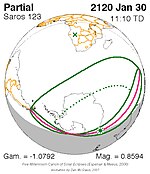 January 30, 2120 (Saros 123) |
 January 9, 2149 (Saros 124) |
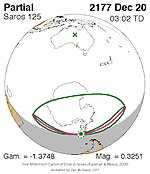 December 20, 2177 (Saros 125) |
|
References
- ^ van Gent, R.H. "Solar- and Lunar-Eclipse Predictions from Antiquity to the Present". A Catalogue of Eclipse Cycles. Utrecht University. Retrieved 6 October 2018.
- ^ "NASA - Catalog of Solar Eclipses of Saros 120". eclipse.gsfc.nasa.gov.

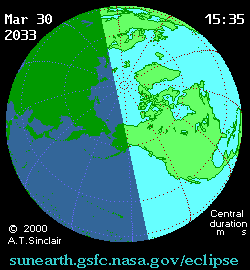




Recent Comments